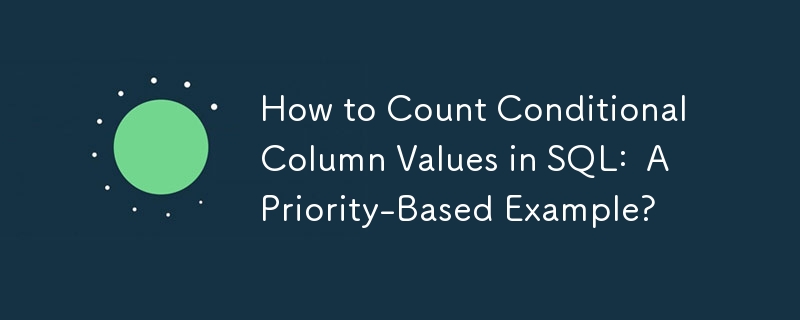Found a total of 10000 related content
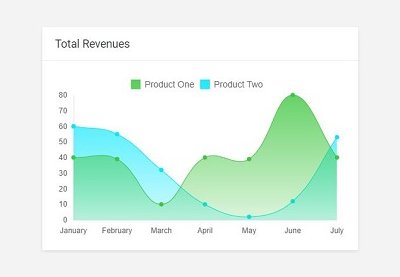
19 Best JavaScript Admin Templates for React, Angular, and Vue.js
Article Introduction:Streamline Your App Development with Top JavaScript Admin Panel Templates
Building an app? Save time and effort with a pre-built JavaScript admin panel template. This article showcases powerful React, Angular, and Vue.js templates to create stunnin
2025-03-10
comment 0
1097

How to disable admin editing in Django Admin Panel
Article Introduction:Django Admin Panel: A Read-Only Approach for Data Management
The Django Admin Panel offers a user-friendly interface for managing models, data, and users. Its built-in search and filtering capabilities are incredibly convenient. However, sometimes r
2025-01-27
comment 0
1217

Enum-Powered Route Permissions in Laravel
Article Introduction:Laravel now simplifies permission checking in routing by adding enumeration support directly in the can() method. This enhancement eliminates the need to explicitly access the value attributes of the enumeration, making the routing definition simpler and more expressive.
This feature is especially great when building admin panels or multi-tenant applications where permission management is critical and you want to take advantage of PHP's type safety features.
Route::get('/admin', function () {
// ...
})->can(Permission::ACCESS_ADMIN);
Here is how to implement the basics in the admin panel
2025-03-06
comment 0
940

Adding a Contextual Help Tab to Custom Post Type Screens
Article Introduction:WordPress context help tags: The key to improving user experience
A small "Help" tab in the upper right corner of the WordPress admin panel will display useful information and usage of each admin page. This is the context help tab. Its "context" feature is that the information displayed is related to the currently viewed management page. For example, clicking on the article editing page will display instructions for customizing the screen display, entering titles and content, inserting media files, and enabling or disabling comments and pingbacks.
For plugin or theme developers, this helps to provide users with fast documentation, thereby reducing customer support issues. If you want to learn topic development, you can check out SitePoi
2025-02-10
comment 0
1136

How to install Emmet in Sublime Text
Article Introduction:Install PackageControl (if not installed): Paste the code through the SublimeText console to install PackageControl; 2. Install Emmet: Open the command panel, select "PackageControl:InstallPackage", search and install Emmet; 3. Verify the installation: After entering html:5 in the HTML file, press the Tab key. The HTML5 template should be generated. Enter m10p5 in the CSS file and enters m10p5 to margin:10px5px; 4. Troubleshooting: Ensure the syntax is correct, restart SublimeText, and check that Emmet is not disabled. After the installation is complete, Emmet will
2025-08-02
comment 0
765
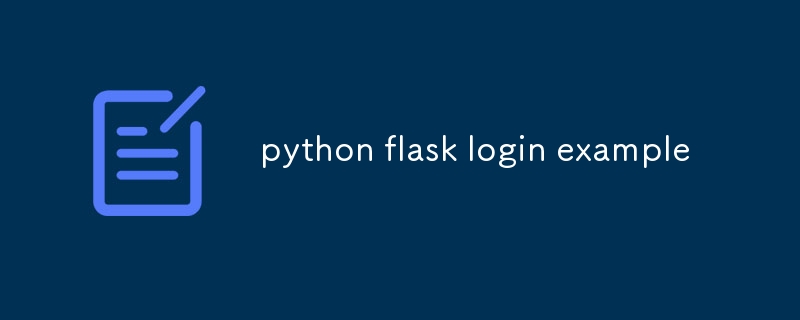
python flask login example
Article Introduction:This is a simple login example based on Flask-Login, including user login, session management, and login protection routing. 1. Install flask and flask-login dependencies; 2. Create app.py file and configure Flask-Login, simulate user data and login callbacks; 3. Implement login, logout and protected dashboard routing; 4. Use the template files login.html and dashboard.html for page rendering; 5. Log in with the user name admin and password password123 after running the application. The complete process covers flash messages, form processing and session retention, which is suitable for beginners to quickly master the Flask login mechanism. It is recommended to introduce the database in the future.
2025-08-01
comment 0
323

How to create a stored procedure in Navicat?
Article Introduction:The key to creating stored procedures in Navicat is to understand the database type and its syntax differences. The following are the specific steps: 1. Preparation: Confirm the connected database type (such as MySQL, PostgreSQL or SQLServer) because the stored procedures of different databases are different syntax; 2. Open the "Store Procedure" panel and create a new one: Enter the stored procedure management interface through the Navicat interface, right-click to select "New stored procedure", enter the name and use the template structure; 3. Write SQL logic: Define parameters and statements, such as adding IN parameters to MySQL and writing query logic in the BEGIN...END block, pay attention to using DELIMITER to set the ending character; 4. Test and call
2025-08-11
comment 0
948
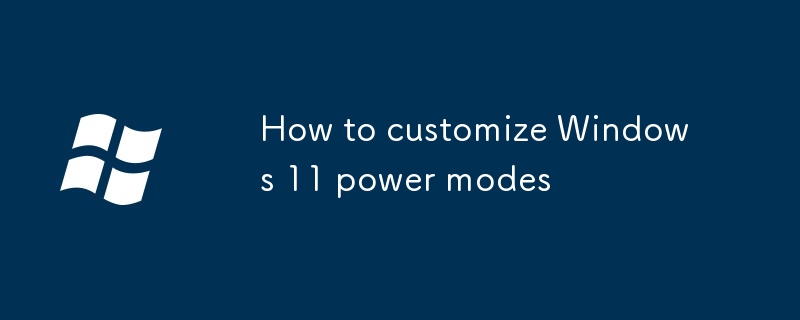
How to customize Windows 11 power modes
Article Introduction:To customize Windows 11 power mode, first you can switch pre-design plans in the taskbar battery icon or control panel, such as "Balance", "High Performance" and "Power Saving"; secondly, click "Create Power Plan" to select the template and set the name, turn off the monitor and sleep time; then, adjust advanced options such as processor power management, hard disk sleep time and USB settings through "Change Plan Settings". Finally, advanced users can further optimize through the powercfg command or registry, such as viewing plans, modifying settings or exporting configurations. It is also recommended to adjust strategies according to the device type, such as notebooks distinguish between battery and power supply, desktops focus on performance settings, and tablets strengthen energy saving.
2025-07-19
comment 0
476

How to use code snippets in VS Code
Article Introduction:Use built-in code snippets: Enter the trigger word in the corresponding language file (such as input for in JavaScript and press the Tab key to generate a for loop, and enter! in HTML and press Tab to generate an HTML5 template), and identify available fragments through the puzzle icon in IntelliSense; 2. Create a custom fragment: Select "Configure User Code Snippet" through the command panel (Ctrl Shift P or Cmd Shift P), and create fragments of global or specific languages, and define the name, prefix, content and description in the open JSON file; 3. The fragment structure includes prefix (trigger word), body (insert the code, and use $1, $2, etc. to represent the jump point, and $0 is the final position
2025-08-11
comment 0
356

How to use the HTML5 Data attributes for custom data.
Article Introduction:HTML5's data attribute is a standard way to store custom data on page elements. 1. It starts with data-, such as data-user-id. The data is invisible to the user but can be accessed through JavaScript; 2. Use the dataset attribute to read or set the data, and the hyphen is converted to camel; 3. Suitable for front-end template rendering, component state management, interactive control and other scenarios; 4. Precautions include avoiding storing sensitive or large amounts of data, preventing naming conflicts, paying attention to data type conversion, and reasonable use to avoid performance problems. Correct use of data attributes can make the front-end logic clearer and more concise.
2025-07-04
comment 0
331


Dave The Diver: How To Catch Spider Crabs
Article Introduction:In Dave The Diver, there are some creatures that are not easy to catch. Or, catch alive that is. The spider crab is one of those very species, making it seem like the only way to bring these crustaceans back up to land is to viciously crack them up w
2025-01-10
comment 0
934

Prepare for Interview Like a Pro with Interview Questions CLI
Article Introduction:Prepare for Interview Like a Pro with Interview Questions CLI
What is the Interview Questions CLI?
The Interview Questions CLI is a command-line tool designed for JavaScript learners and developers who want to enhance their interview
2025-01-10
comment 0
1552
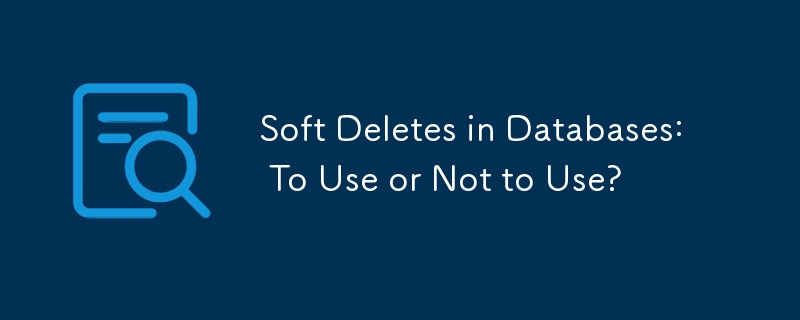
Soft Deletes in Databases: To Use or Not to Use?
Article Introduction:Soft Deletes: A Question of DesignThe topic of soft deletes, a mechanism that "flags" records as deleted instead of physically removing them, has...
2025-01-10
comment 0
1124












